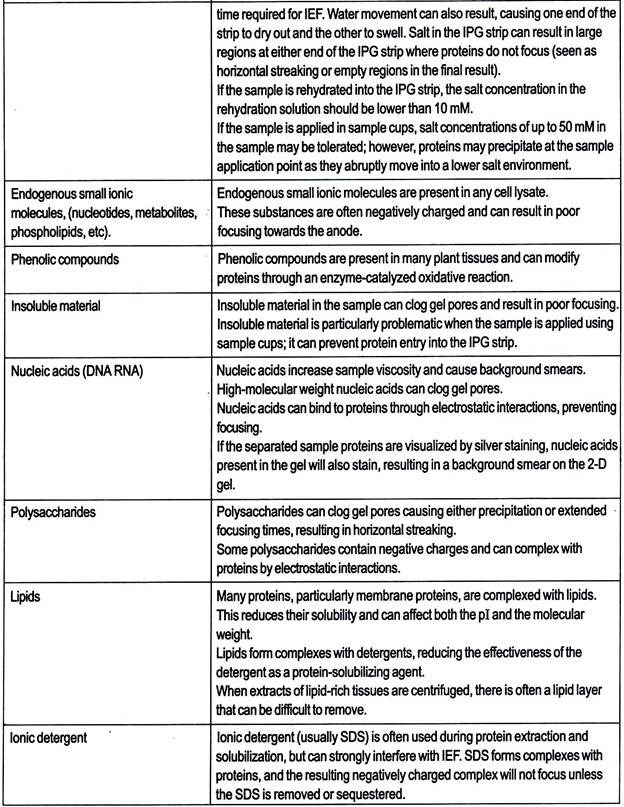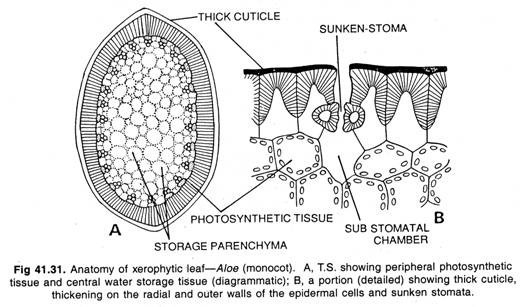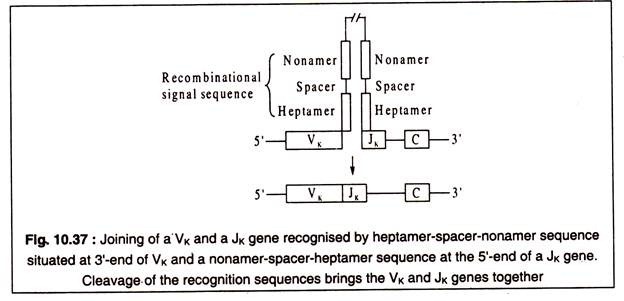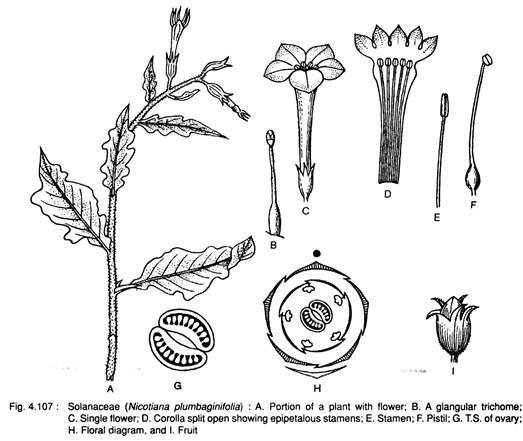ADVERTISEMENTS:
In this essay we will discuss about top three families of dicotyledons:- 1. Rosaceae (Rose Family) 2. Cucurbitaceae (Gourd Family) 3. Solanaceae (Potato Family).
Essay # 1. Rosaceae (Rose Family):
The family is represented by 110 genera and 3,100 species, is cosmopolitan in distribution. More than-25 genera and 215 species are growing widely in the temperate region of Himalayas up to an about 1,980 m (6,500 ft). The plants of this family are important as cash crops.
The type genus of the family is Rosa.
ADVERTISEMENTS:
Systematic Position:
Identifying Characteristics:
ADVERTISEMENTS:
1. Plants herbs, shrubs or trees.
2. Leaves alternate, simple or compound. Usually stipulate and more commonly of adnate type.
3. Flowers usually bisexual and regular, pentamerous.
4. Sepals 5 and are basally connate.
5. Petals 5 or more, free, inserted on receptacular cup or hypanthium.
6. Stamens numerous.
7. Ovary superior or inferior, ovules on axile placentation.
8. Carpel 1-many, free or connate.
Floral Formula:
Rosaceae: Distinctive Features:
Phylogeny and Systematic:
The family Rosaceae is related to the family Leguminosae (Fabaceae). This family is an assemblage of fairly primitive and advanced characteristics. Most of the taxonomists included the family under the order Rosales. Bentham and Hooker placed the Natural order Rosaceae under the cohort Rosales, subclass Polypetalae and class Dicotyledons.
Engler and Prantl also placed it in Rosales after Sarraceniales, under the subclass Archichlamydeae and class Dicotyledonae. Hutchinson placed Rosaceae under Rosales and given a comparatively primitive position and placed after the 5th order Coriariales under division Lignosae and sub-phylum Dicotyledones.
ADVERTISEMENTS:
Recently, Takhtajan and Cronquist placed Rosaceae under Rosales of subclass Rosidae, class Magnoliopsida. Although the family Rosaceae is a more natural assemblage, still many taxonomists treated most of the tribes (= subfamilies) as independent families.
Common Plants:
1. Eriobotrya japonica Lindl.;
2. Fragaria vesca L.;
ADVERTISEMENTS:
3. Malus sylvestris (L.) Mill. (Syn. Pyrus malus L.);
4. Potentilla nepalensis Hook;
5. Prunus ceresus L.;
6. Pyrus communis L.;
7. Rosa alba L. (Indian white rose);
8. R. centifolia L. (Cabbage rose);
ADVERTISEMENTS:
9. R. chinensis Jacq. (Syn. R. indica L.)
10. R. damascena Mill.;
11. Rubus hexagynous Roxb.
Key to Genera:
I. Ovary superior; ripe carpels not enclosed within the calyx-tube
1. Carpel Solitary:
ADVERTISEMENTS:
i. Leaves simple, quite entire, fruit 2- seeded ……………… Pygeum.
ii. Leaves simple, serrate, fruit 1-seeded ……………………. Prunus.
2. Carpels Many:
A. Unarmed herbs; ripe carpels dry; ovules solitary
i. Leaves compound, fruit achenes on fleshy receptacle ………. Fragaria.
ii. Leaves compound fruit achenes on dry receptacle ………. Potentilia.
B. Armed shrubs; leaves simple or compound, with stipules adnate or free; carpels many or few on a convex receptacle; fruit drupe …………… Rubus.
II. Ovary Inferior; Ripe Carpels Enclosed within the Calyx-Tube:
Carpels many, not confluent when ripe:
A. Armed shrubs; leaves compound with adnate stipules; fruit a fleshy calyx- tube enclosing bony achenes… Rosa.
B. Shrubs or trees; leaves simple, coriaceous, usually serrate; flowers white, panicled; fruit 1 -seeded dry or succulent berry, endocarp membranous …….. Eriobotrya.
C. Shrubs or trees; leaves simple or compound; flowers white, red or pink, in terminal corymbs …….. Pyrus.
Plants of Economic Importance:
The members are the good source of large number of economically important fruits, some are ornamental and some other medicinal plants. Some plants are also used for different purposes.
A. Edible Fruits:
Some members are good source of edible fruits and are economically very important.
These are:
1. Eriobotrya japonica (Loquat),
2. Fragaria chiloensis(Garden strawberry),
3. F. vesca (Alpine strawberry),
4. Malus sylvestris (Apple),
5. Prunus amygdalus (Almond),
6. P. armeniaca (Apricot),
7. P. avium (Sweet cherry),
8. P. cerasus (Sour cherry),
9. P. domestica var. institia (Plum),
10. P. persica (Peach),
11. Pyrus communis (Pear),
12. P. pyrifolia var. culta (syn. P. sinensis) (Chinese pear).
B. Ornamental Plants:
Many plants with beautiful flowers are extensively cultivated in the garden.
These are:
1. Rosa (Garden Rose):
Different species of Rosa are commonly cultivated in the garden. These are R. banksiae, R. centrifolia, R. damascena, R. indica, R. muitiflora, etc.
2. Spiraea (Spirea):
Different species are cultivated in the garden in fences, lawn and also in borders. These are S. cane- scens, S. cantoniensis, S. japonica, etc.
3. Potentilla, Rubus and Sorbus:
Different species are grown in the garden as ornamental plants.
C. Medicinal Plants:
1. Genum Urbanum:
Root stocks are used in chronic dysentery, diarrhoea etc.
2. Hagenia Abyssinica:
The panicles of female flowers are used as the source of anthelmintic drug etc.
3. Potentilla Anserina (Silver Weed):
The plant is used to control arthritis, kidney stone, etc.
D. Other Uses:
1. Perfume:
The flowers of Rosa damascena are good source of valuable perfume.
2. Edible Oil:
The seeds of Prinsepia utilis are the source of edible oil used in cooking.
3. Emulsifier:
The bark of Quillaja saponaria (Soap bark) is used as an emulsifying and foaming agent in hair tonic and in shampoo.
4. Handle of Tools, Walking Sticks, etc.:
The woody branches of some plants are used for various purposes like handle of tools, walking sticks, etc. These are Crataegus oxyacantha, Pyrus communis, Rosa brunonii, etc.
Essay # 2. Cucurbitaceae (Gourd Family):
The family is represented by 118 genera and 760 species, out of which 37 genera and about 97 species are reported from India, mainly from tropical regions. The family is important as cash crop mainly for vegetables.
The type genus of the family is Cucurbita.
Systematic Position:
Identifying Characteristics:
1 Succulent herbs with extra axillary tendril,
2. Flower unisexual, actinomorphic, pentamerous and epigynous,
3. Stamens-5, generally synandrous (both anthers and filaments are united),
4. Carpel-3, ovary — inferior, ovules many in each cell on parietal placentation,
5. Fruit — fleshy berry-like or pepo.
Floral Formula:
Types of Androecium:
The androecium shows much variation in its arrangement of stamen.
These are:
1. All the five stamens remain free, they alternate with the petals. Anthers dithecous. e.g., Fevillea.
2. All the five stamens remain free but anthers monothecous. e.g. Luffa cylindrica.
3. Stamens-5, the filaments of 4 stamens are united at the base into two pairs, the 5th stamen remains free, anthers monothecous. e.g., Thladiantha.
4. Stamens apparently 3 (actually 5), two with dithecous anthers and one with monothecous anther. This condition seems to appear due to the complete union of the filaments and anthers of two pair of stamens, e.g., Cucumis, Citrullus and Lagenaria.
5. Stamens apparently 3 (actually 5), two with dithecous anthers and one with monothecous anther. Here the filaments become connate and the anthers become very much twisted, e.g., Cucurbita.
6. All the 5 stamens are united into a column and they are remarkably curved, e.g., Sicyos.
7. The stamens are strictly monadelphous, where all the 5 stamens are united into a column with two ring-like pollen chambers situated around the top. The anthers dehisce by a single transverse slit, e.g., Cyclanthera.
Phylogeny and Systematic:
The family is closely related with Campanulaceae and also with Solanaceae.
The position of Cucurbitaceae shows great variation according to the different taxonomists. Bentham and Hooker placed the natural order Cucurbitaceae under the cohort (= order) Passiflorales, series Calyciflorae, sub-class Polypetalae of the class Dicotyledons.
Engler and Prantl considered the family as a comparatively advanced one and placed it alone under the order Cucurbitales next to Campanulales, subclass Metachlamydeae of the class Dicotyledoneae.
Hutchinson placed the family along with Bignoniaceae, Dasticaceae and Caricaceae under the order Cucurbitales (30th) after Passiflorales (29th), division Lignosae of sub- phylum Dicotyledones. Later, Takhtajan placed the family Cucurbitaceae alone under the order Cucurbitales and placed the order between Passiflorales and Begoniales.
According to him the family is allied to Passifloraceae on one side and to Begoniaceae and Datiscaceae on other side. Still later, Cronquist included the family in the order Violales next to Nepenthales, along with many families like Begoniaceae, Datiscaceae, Passifloraceae, Loasaceae, Turneraceae, Ancistrocladaceae, etc.
Common Plants:
1. Citrullus lanatus (Thunb.) Mak. (Syn. Citrullus vulgaris Schard.) Tarbuz (Water melon);
2. Coccinia grandis (L.) Voigt. – Telakucha;
3. Cucumis melo L. – Kharbuz;
4. C. sativa L. – Sosha (Cucumber);
5. Cucurbita maxima Duch. – Mitha kumra, Mitha kadu, Red pumpkin (Spanish gourd, Gourd);
6. C. moschata Duch. Ex Poir. – Safra kumra (Musk melon);
7. C. pepo DC – Kumra, Safed kadu (Field pumpkin);
8. Lagenaria siceraria (Standl.) – Louki, Lau (Bottle gourd);
9. Luffa acutangula (L) Roxb. – Jhinga;
10. L. cylindrica (L.) Roem. – Dhundul (Bath sponge);
11. Melothria heterophylla Cogn. (Syn. Zehneria umbellata Thw.) – Kudari;
12. M. maderaspatana Cong. (Syn. Mukia scabrella Arn.). – Billari.
13. Momordica charantia Linn. – Karela (Bitter gourd);
14. M. cochinchinensis (Lour.) Spreng – Kakrol;
15. Trichosanthus anguina L. (Snake gourd, Chichinga);
16. T. cucumereina Linn. – Banchichinga;
17. T. dioica Roxb. – Palwal, Patol;
18. T. palmata Roxb. (Syn. T. bracteata (Lamk.) Voigt.) – Mahakala, Makal.
Key to Genera:
I. Anther-cells ‘S’-shaped or folded, Corolla rotate or campanulate, divided or nearly so into 5 petals above:
1. Tendril divided…
i. Flowers white; petals fimbriated at the margin; seeds many …Trichosanthes.
ii. Flowers large, white; petals entire; anthers included; petiole with 2 glands ………. Lagenaria.
iii. Flowers pale yellowish-white; petals fimbriated; seeds many … Hodgsonia.
Stamens inserted at the mouth of the calyx-tube; anthers free; flowers yellow:
a. Fruit dry, angled or ribbed, rarely smooth; endocarp fibrous, opening by special lid; male flowers borne in raceme ……………. Luffa.
b. Fruit fleshy, soft, indehiscent; male and female flowers both solitary ……………… Benincasa.
Stamens inserted below the mouth of the calyx-tube:
a. Male and female flowers large, yellow, solitary; corolla divided half way down, ovate-obtuse; anthers scarcely connate ………………… Citrullus.
b. ♂ and ♀ flowers solitary, yellow, large, corolla lobes short, triangular; anthers connate ………………. Cucurbita.
2. Tendril simple …
i. Leaves cordate; male flowers sub-raceme; calyx with 2-3 scales; fruit tuberculated, spinous … Momordica.
ii. Leaves lobed; male flowers clustered; calyx without scales; fruit large, smooth, edible; connective protruding beyond the anther-cells ……………………………….. Cucumis.
iii. Leaves palmately lobed; flowers white; fruit a smooth cylindric berry ………………………. Coccinia.
iv. Leaves toothed, angled or deeply lobed; flowers yellow; plants simple …………………………. Zehneria.
II. Anther-cells straight or somewhat curved.
Male and Female Flowers Clustered, Small, Yellow:
1. Tendril simple…………………………… Mukia.
2. Tendril divided………………………… Bryonia.
Plants of Economic Importance:
A. Fruit-Vegetables:
1. Benincasa hispida (White squash or Chalkumra),
2. Cucurbita pepo (Pumpkin),
3. C. maxima (Red pumpkin),
4. C. moschata (musk melon),
5. Lagenaria siceraria (Bottle gourd or lau),
6. Trichosanthus dioica (Palwal),
7. T. anguina (Snake gourd, Chachinga),
8. Sechium edule (Squash).
B. Edible Fruits:
1. Citrullus lanatus (Tarbuz, Water melon),
2. Cucumis sativus ( Sosa, Cucumber),
3. C. melo (Kharbuz).
C. Making Musical Instruments:
Benincasa hispida and Lagenaria siceraria – Mature fruits with hard pericarp are used for making musical instruments and several decorative articles.
D. Medicinal Plants:
1. Bryonia calliosa – Seeds are used as vermifuse,
2. B. rostrata – Roots are used in the treatment of piles and asthma.
E. Ornamental Plants:
Different species of Ecballium, Coccinia, Sechium and Cyclanthera are grown as ornamental plants.
Essay # 3. Solanaceae (Potato Family):
The family Solanaceae is represented by 83 genera and more than 2,925 species, they grow in the temperate and tropical regions of the world. Their availability is very common in South and Central regions of America. The family is represented in India by 15 genera and 88 species, chiefly found to grow in Eastern and Southern parts and also in Himalayan range.
The type genus of the family is Solanum.
Systematic Position:
Solanaceae: Distinctive Features:
Identifying Characteristics:
1. Plants are herbs, or shrubs.
2. Leaves simple, exstipulate and arranged alternately.
3. Inflorescence extra-axillary cymose.
4. Flowers bisexual, regular and hypogynous.
5. Calyx persistent on fruit.
6. Corolla rotate or funnel-shaped.
7. Carpel – 2, syncarpous, ovary obliquely placed.
8. Fruit – Usually many seeded berry.
Floral Formula:
Phylogeny and Systematic:
The family is closely related to Convolvulaceae and Scrophulariaceae. Many taxonomists placed both the families Solanaceae and Convolvulaceae under Solanales for the similarity in floral characteristics but differ in habit. The family shows similarity with Scrophulariaceae, but differs in the presence of bicollateral vascular bundle, commonly actinomorphic corolla and 4 or 5 stamens.
Bentham and Hooker placed the natural order Solanaceae under cohort (= order) Pole- moniales, series Bicarpellatae, subclass Gamopetalae of class Dicotyledons. Engler and Prantl placed the family under the order Tubiflorae, subclass Metachlamydae of class Dicotyledoneae.
Later, Hutchinson placed the family under the order Solanales, division Herbaceae in the sub- phylum Dicotyledones. Takhtajan placed the family under the order Scrophulariales, but Cronquist — following Bentham and Hooker — placed it under Polemoniales.
Bentham and Hooker divided the family into 5 tribes.
These are:
1. Solaneae.
2. Atropeae.
3. Hyoscyameae.
4. Cestrineae.
5. Salpiglossidae.
The last tribe Salpiglossidae having zygomorphic flower was treated by Hutchinson as a separate family Salpiglossaceae and zygomorphy with 2 or 4 stamens forms a connecting link between Solanaceae and Scrophulariaceae.
Common Plants:
1. Browallia alata L.;
2. Cestrum diurnum L.;
3. Datura mete I L.;
4. Nicotiana plumbaginifolia Viv.;
5. Solanum nigrum L.;
6. S. surattense Burm. (Syn. S. xanthocarpum Schrad. and Wendl);
7. 5. torvum Swartz.;
8. 5. trilobatum L.;
9. S. verbascifolium L. – a small tree.
Key to Genera:
I. Corolla-limb valvate; fruit usually a berry; seeds more or less discoid, compressed; embryo peripheric:
1. Anthers opening through 2 apical pores, connivent in a cone …
i. Leaves simple, lobed or pinnatifid …………. Solanum.
2. Anthers dehiscing by longitudinal slit…
i. Dehiscence introrse, leaves pinnate …………….. Lycopersicon.
ii. Calyx small in fruit; anthers equal or shorter than the filament; flowers small, in paired pedicles or simple …………….. Capsicum.
iii. Calyx enlarging in fruit, covering the berry, shortly lobed; pedicels solitary ………….. Physalis.
iv. Calyx enlarging in fruit, overtopping the berry; pedicels clustered ……………………… Withania.
II. Corolla-lobes imbricate; embryo curved:
i. Capsule 4-valved, semi-indehiscent; flowers solitary, axillary; stamens all perfect ………….… Datura.
ii. Capsule circumscissile; fls. unilateral, upper racemose ………………….. Hyoscyamus.
III. Corolla-lobes induplicate-valvate; embryo straight; fruit capsular; flowers panicled… Nicotiana.
IV. Corolla-lobes subplicate-imbricate; embryo straight or slightly curved; fruit membranous or subcoriaceous capsule; flowers white or blue, solitary axillary, or the upper-most passing into a 1-sided terminal raceme …………. Browallia.
Genus Solanum:
Key to Species:
I. Stem Armed:
1. Flowers white……………………………. torvum.
2. Flowers blue
i. Plant erect with stout stem and leaves wooly …………… indicum.
ii. Plant not erect with weak stem and leaves glabrescent.
a. Diffuse herb………… surattense.
b. Climbing shrub………. trilobatum.
II. Stem Unarmed:
1. Herb with glabrous stem and leaves…………………….. nigrum.
2. Small tree with tomentose stem and leaves …………….. verbascifolium.
Plants of Economic Importance:
The family is very much useful to the mankind for vegetables, fruits, drugs, tobacco and also for ornamental plants.
A. Vegetables:
1. Capsicum annum (Chillies, Mirch). The fruits are used for chilli powder of commerce, a common spice.
2. C. frutescens. The fruits are used as vegetable and also used in making hot sauces.
3. Lycopersicon esculentum [Syn. Solanum lycopersicum (Tomato)]. Both unripe and ripe fruits are used as vegetable. The ripe fruits are used in the preparation of ketchup (a sauce made from mushroom) and sauce.
4. Solanum tuberosum (Potato, Alu). The underground stem i.e., the tuber of the plant is rich in carbohydrates and sugars. It is the main food of the people of Ireland like rice in Bengal (India). It is commonly used as an additional food as boiled, fry and in curries along with other vegetables.
Tubers are also used in different industries in the production of dextrin, starch and alcohols.
5. S. melongena (Brinjal, Begun). The fruits are available in different sizes and are used as vegetables.
B. Fruits:
Physalis peruviana (Raspberry). The orange red fruits are edible.
C. Drugs:
1. Atropa belladonna (Belladonna). The roots of the plant are the source of atropine, an alkaloid. It is used to control spasm of involuntary muscles, relieving pains and dilating pupils. It can act against opium poisoning.
2. Datura stramonium (Datura), D. meteI and D. inoxia. The leaves and flowering tops contain the drug, stramonium; used in the treatment of asthma and Parkinson diseases. The seeds are deadly poisonous. The fruit juice is used on head to check falling of hairs and also dandruff.
3. Hyoscyamus niger (Henbane). The leaves and the flowering tops contain the ‘henbane’ drug of commerce. It is used to control whooping cough and asthma.
4. Mandragora autumnalis. The roots of the plant have hypnotic and sedative properties.
5. Nicotiana tabacum and N. rustica. The tobacco prepared from the dried and curved leaves are employed in medicine as antispasmodic, sedative and vermifuge.
ADVERTISEMENTS:
6. Withania coagulans (Indian rennet). The fruits of the plant are used to control liver and colic problem and also for asthma. It is also used as blood purifier.
7. W. somnifera (Aswagandha). The roots contain the drug ‘Asgandh’ used to control female disorders, rheumatism, hiccup and also for cough.
D. Tobacco:
Nicotiana tabacum and N. rustica. The tobacco is prepared from the dried leaves. The tobacco is used in the preparation of cigarette, bidi, cigar, pipe tobacco, snuff, etc.
E. Ornamental Plants:
Many plants of this family are grown in the garden as ornamental plants:
1. Browallia alata.
2. Brunfelsia americana (Lady-of-the night), B. calycina (Franciscea), B.latifolia.
3. Cestrum diurnum (Day jasmine), C. noc- turnum (Night jasmine) and C. parqui (Willow-leaved jasmine).
4. Nicotiana alata.
5. Petunia hybrida and P. violacea.
6. Salpiglossis sinuata (Painted tongue).
7. Solanum dulcamara, S. seaforthianum and S. jasminoides.
F. Other Uses:
Nicotiana tabacum. The oil extracted from seeds is used in paints and varnishes. The powered leaves are used as insecticide to control insect pests.






















